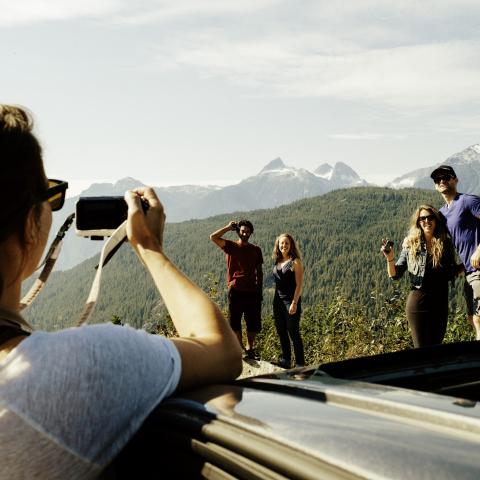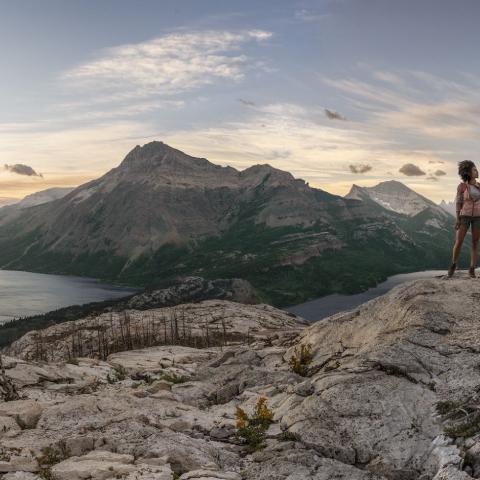Author: Leslie Anthony
Ski areas might be the only place in the world where explosions are an acceptable alarm clock. Indeed, the percussive reverberations of avalanche-control bombs are a welcome sound that draws skiers up from the valley like a siren call to the peaks. With its dual mountains and vast alpine acreage to manage, Whistler Blackcomb may offer a more relentless alarm than most, but that only reflects the greater rewards of heeding its call.
It all starts with a snowfall. Packing moisture from Hawaii and Arctic air from the Gulf of Alaska, winter storms fly in from the North Pacific to land on the B.C. coast. Brooding and powerful, these tempests are girded for battle—fighting to find a way up, over and through a labyrinth of mountains. Frustrated at the rocky barrier posed by the Coast Range, they release a tantrum of snow at the first opportunity. Cue Whistler Blackcomb—recipient of this largesse to the tune of almost 36 feet each winter. Snow is a common-enough occurrence here that most visitors who spend more than a couple of days will discover why a powder day in Whistler, with its abundance of space and diversity of terrain, is something special. An experience within an experience, if you will—and one with a contagious vibe.
There might be more snow than people are used to, delayed lift openings, and stormy conditions, but don’t be intimidated. Embracing Mother Nature at her most furious with a modest plan will yield serious dividends. If you’re not hiring a ski school or alpine bureau guide to find your way through the maelstrom (a great option, BTW), common-sense strategy goes a long way toward maximizing your enjoyment. On big snow days I’m always thinking my way around these mountains; as an example, here’s how my partner and I might navigate a 20-inch powder day.
First, we get to the lifts early. Sure, ongoing bombing means the alpine won’t open for a while, but the lower- and mid-mountains—the equivalent of several regular-sized ski areas—are good to go. It’s still snowing, so our first move on the gondola ride up is to check wind direction, knowing lee areas will be deeper. Next, we look at the grooming report; there’s no better way to warm up—and few as outright fun—than a groomer with fresh snow atop it. The comfort of a predictable base allows you to go faster, getting you into that all-important snow-slashing rhythm. And there are always more than enough of Whistler Blackcomb’s 200 runs open to keep you occupied until those alpine lifts start cranking.
We start our day on Blackcomb for several reasons: more mid-mountain options, generally fewer people, and an alpine that tends to open far ahead of Whistler’s. In part this is due to geology: the terrain on Whistler is more complex, with trickier pockets, cornices and bowls that require more bombing to open safely; it’s also larger—4,750 skiable acres to Blackcomb’s 3,400—with a greater share of treeless alpine. This operational wrinkle is actually a bonus: skiers can enjoy all Blackcomb has to offer and then, when the Whistler alpine opens, move over to “fresh” horizons.
Right now, however, it’s all about Blackcomb, where some of the best skiing is the most obvious: the long, luxurious frontside runs are spacious enough to accommodate hundreds of first tracks. Backdropped by the almost continuous eruptions of Woohoo! from unseen skiers we make a couple of life-affirming laps, the new snow topping our boots and rushing up our legs, before heading over to Jersey Chair just as it opens. There we join knots of giddy locals adhering to the 12-inch rule (wherein both bosses and employees skip work to go skiing). Smiles abound and the energy is palpable, increasing everyone’s excitement. At the top, instead of skiing back down like most, we head toward Seventh Heaven. It isn’t open yet, but the traverse passes a series of cut glades that concentrate snow sifting up the Fitzsimmons Valley, which funnels the region’s primarily southwest winds along Blackcomb’s flank. The glades are no secret—they’re on the trail map—but like a dozen other options, often overlooked in the frontside frenzy; today they’re deep and delicious. By the time we’ve made it back around front and up to Rendezvous Lodge, eyes that have been scrutinizing phone apps for information all morning are firmly fixed on the lift-status lightboard, where everything now suddenly shifts from yellow to green.
We watch the milling crowd literally part, a majority heading to the wonderland of Seventh Heaven, with its room to roam, piles of snow, and so much choice they’ll be there for a while. It’s our signal to head up Glacier Chair and make the short Spanky’s Ladder hike that accesses Ruby, Diamond, Sapphire and Garnet Bowls. We decide on Ruby to avoid the snow-choked flats at the bottom of the others. The knee-deep descent proves worthy and we’re literally glowing as we hatch the next part of our plan.
While riders are still busy attacking the mountain, we opt for an early lunch at Crystal Hut—smothering their specialty waffles with every sugary topping we can get our hands on. We’ll need energy for the ambitious afternoon we’ve mapped out. Whistler’s alpine is still on standby but won’t be for long: we’ll hit Harmony Bowl first, then possibly bootpack up Flute Peak and make a run down and into Symphony Bowl if it’s open. We’ll finish the day on Peak Chair, skiing the glorious, 11-km Peak to Creek run all the way to Creekside Base and beers with friends at Dusty’s Bar & BBQ. Of course, to access any of this we still have to get to Whistler Mountain’s Roundhouse, some three miles away as the crow flies across the Fitzsimmons Valley. No worries, though: the 12-minute ride on the Peak 2 Peak Gondola represents not only a marvel of engineering, but possibly the most brilliant powder-day convenience known to mankind—next to an avie-bomb alarm clock.









